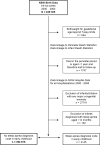Sleep apnea in early childhood associated with preterm birth but not small for gestational age: a population-based record linkage study
- PMID: 23115396
- PMCID: PMC3466794
- DOI: 10.5665/sleep.2192
Sleep apnea in early childhood associated with preterm birth but not small for gestational age: a population-based record linkage study
Abstract
Study objectives: Investigate the relationship between gestational age and weight for gestational age and sleep apnea diagnosis in a cohort of children aged up to 6 years old.
Design: A cohort study, using record linked population health data.
Setting: New South Wales, Australia.
Participants: 398,961 children, born between 2000 and 2004, aged 2.5 to 6 years.
Measurements: The primary outcome was sleep apnea diagnosis in childhood, first diagnosed between 1 and 6 years of age. Children with sleep apnea were identified from hospital records with the ICD-10 code G47.3: sleep apnea, central or obstructive.
Results: A total of 4,145 (1.0%) children with a first diagnosis of sleep apnea were identified. Mean age at first diagnosis was 44.2 months (SD 13.9). Adenoidectomy, tonsillectomy, or both were common among the children diagnosed with sleep apnea (85.6%). Children born preterm compared to term were significantly more likely to be diagnosed with sleep apnea (< 32 weeks versus term hazard ratio 2.74 [95% CI: 2.16, 3.49]) this remained even after adjustment for known confounding variables. Children born small for gestational age were not at increased risk of sleep apnea compared to children born appropriate for gestational age, hazard ratio 0.95 (95% CI 0.86-1.06).
Conclusions: This is the largest study investigating preterm birth and sleep apnea diagnosis and suggests that diagnosis of sleep disordered breathing is more prevalent in children born preterm, but not those who are small for gestational age.
Keywords: Premature infant; apnea; cohort study; record linkage.
Figures
Comment in
-
Premature birth: an important but frequently overlooked risk factor for OSA.Sleep. 2012 Nov 1;35(11):1441-2. doi: 10.5665/sleep.2178. Sleep. 2012. PMID: 23115389 Free PMC article. No abstract available.
References
-
- Montgomery-Downs H, Jones V, Molfese VJ, Gozal D. Snoring in preschoolers: associations with sleepiness, ethnicity, and learning. Clin J Pediatr. 2003;42:719–26. - PubMed
-
- Calhoun DA. Obstructive sleep apnea and hypertension. Curr Hypertens Rep. 2010;12:189–95. - PubMed
-
- Hultcrantz E, Lofstrand Tidestrom B. The development of sleep disordered breathing from 4 to 12 years and dental arch morphology. Int J Pediatr Otorhinolaryngol. 2009;73:1234–41. - PubMed
-
- Saigal S, Doyle LW. An overview of mortality and sequelae of preterm birth from infancy to adulthood. Lancet. 2008;371:261–9. - PubMed
Publication types
MeSH terms
LinkOut - more resources
Full Text Sources
Medical



